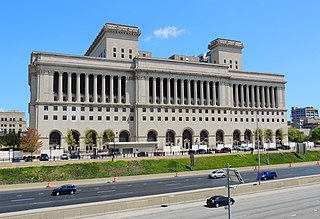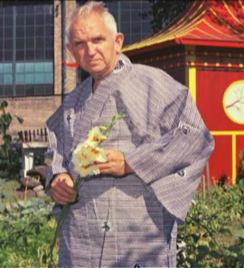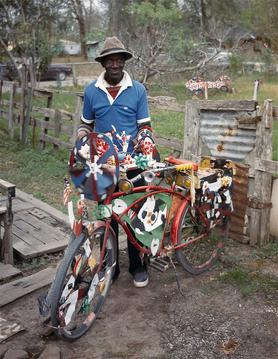
Outsider art is art made by self-taught individuals who are untrained and untutored in the traditional arts with typically little or no contact with the conventions of the art worlds.

Alex Grey is an American visual artist, author, teacher, and Vajrayana practitioner known for creating spiritual and psychedelic artwork such as his 21-painting Sacred Mirrors series. He works in multiple forms including performance art, process art, installation art, sculpture, visionary art, and painting. He is also on the board of advisors for the Center for Cognitive Liberty and Ethics, and is the Chair of Wisdom University's Sacred Art Department. He and his wife Allyson Grey are the co-founders of The Chapel of Sacred Mirrors (CoSM), a non-profit organization in Wappingers Falls, New York.

Nek Chand Saini was a self-taught Indian artist, known for building the Rock Garden of Chandigarh, an eighteen-acre sculpture garden in the city of Chandigarh.
Eugene Von Bruenchenhein (1910–1983) was an American self-taught artist from Milwaukee, Wisconsin. Over the course of fifty years, from the 1930s until his death in 1983, Von Bruenchenhein produced an expansive oeuvre of poetry, photography, painting, drawing and sculpture. His body of work includes over one thousand colorful, apocalyptic landscape paintings; hundreds of sculptures made from chicken bones, ceramic and cast cement; pin-up style photos of his wife, Marie; plus dozens of notebooks filled with poetic and scientific musings. Never confined to one particular method or medium, Von Bruenchenhein continually used everyday, discarded objects to visually explore imagined past and future realities.

The Milwaukee County Courthouse is a high-rise municipal building located in downtown Milwaukee, Wisconsin. Completed in 1931, it is the third county courthouse to be built in the city and is listed on the National Register of Historic Places. The first two courthouses were built at what is now Cathedral Square Park on the east side of the Milwaukee River.

The Mary Nohl Art Environment is a residence in the Milwaukee suburb of Fox Point, Wisconsin. The property, which is filled with folk art created by artist Mary Nohl (1914–2001), is listed on the National Register of Historic Places.

A visionary environment or fantasy world is a large artistic installation, often on the scale of a building or sculpture parks, intended to express a vision of its creator. The subjective and personal nature of these projects often implies a marginal status for the artists involved, and there is a strong association between visionary environments and outsider art.

The Rock Garden of Chandigarh is a sculpture garden for rock enthusiasts in Chandigarh, India. It is also known as Nek Chand Saini's Rock Garden of Nathupur after its founder Nek Chand Saini, a government official who started building the garden secretly in his spare time in 1957. It has spread over an area of 40 acres (16 ha), and is completely built from industrial, home waste, and discarded items.

The Letter Carriers' Monument is a piece of public art by American artist Elliot Offner, located on a triangular plot formed by North 2nd Street, North Plankinton Avenue and West Wells Street in downtown Milwaukee, Wisconsin, in the United States. Created in 1989, the monument depicts three letter carriers and was commissioned in celebration of the centennial of the National Association of Letter Carriers (NALC).

Boy with Goose, is a public artwork by Italian artist Girolamo Piccoli, currently in storage in Milwaukee, Wisconsin, United States.

Angel in a Cage is a public artwork by American artist Richard Pflieger located on Canal Street, which is in Milwaukee, Wisconsin, United States. The public sculpture is made up of a steel tower with an angel suspended inside.

The Washington Monument is a public artwork by American artist Richard Henry Park located on the Court of Honor in front of the Milwaukee Public Library Central Library, which is near Marquette University in Milwaukee, Wisconsin. The bronze sculpture is a full-length portrait of a 43-year-old George Washington, and stands on a granite pedestal; a bronze woman points up at Washington while a child, also made out of bronze, gazes upward. It was sculpted by Richard Henry Park and was erected in 1885 with philanthropic financial support from Elizabeth Plankinton. The statue was restored between July 2016 and January 2018.
Memorial for Belle Austin Jacobs is a public artwork by American artist Sylvia Shaw Judson (sculptor) and Alexander C. Eschweiler (architect), formerly located in Kosciuszko Park, Lincoln Village, City of Milwaukee, Wisconsin, United States. The statue depicted a young woman kneeling to feed a squirrel. It celebrated the life and philanthropy of Belle Austin Jacobs, who was best known for her work, with her husband Herbert Henry Jacobs, as the founders of organized social work in Wisconsin, including the establishment of the University Settlement House.

Lynden Sculpture Garden is a 40-acre outdoor sculpture park located at 2145 West Brown Deer Road in Milwaukee, Wisconsin in Milwaukee County. Formerly the estate of Harry Lynde Bradley and Margaret Blakney Bradley, Lynden is home to the collection of more than 50 monumental sculptures collected by Margaret Bradley between 1962 and 1978. The collection features works by Alexander Archipenko, Henry Moore, Barbara Hepworth, Clement Meadmore, Marta Pan, Tony Smith, Mark di Suvero and others sited across 40 acres of park, lake and woodland.

Spillover is a public artwork by Spanish artist Jaume Plensa. It is installed in Atwater Park in Shorewood, Wisconsin, United States. It depicts an 8.5-foot (2.6 m) crouching man whose open form is made of steel letters. It is on a 2-foot (0.61 m) concrete base, and was publicly dedicated on September 21, 2010.

Sidney Edward Boyum was an industrial photographer, sculptor and graphic artist in Madison, Wisconsin, United States. Much of his work falls into the category of outsider art. Boyum is best known for his public sculptures scattered throughout the Schenk-Atwood-Starkweather-Yahara Neighborhood on Madison's east side.
Emery O. Blagdon was an American artist.

David Butler (1898–1997) was an African American sculptor and painter from Good Hope, Louisiana. His style is epitomized by kinetic sculptures made from recycled tin or wood, which he embellished with saturated colors and geometric patterns. His work is now in the permanent collections of the Smithsonian American Art Museum, the American Folk Art Museum, and the Philadelphia Museum of Art.
Ruth DeYoung Kohler II was a museum director and teacher from Wisconsin who championed under-recognized, self-taught artists and vernacular art. She was the director of the John Michael Kohler Arts Center from 1972–2016. She led the development of the Art Preserve in Sheboygan, Wisconsin, the first museum dedicated to the exhibition and conservation of artist-built environments.

The Art Preserve is an art museum and a satellite campus of the John Michael Kohler Arts Center. The preserve houses a collection of artist-built environments and sculptural works. It is designed by Tres Birds and located in Sheboygan, Wisconsin. Opened in June 2021, the Art Preserve is the first museum dedicated to the exhibition, preservation, and care of artist-built environments. The museum also serves as a research space for the art environment genre.




















